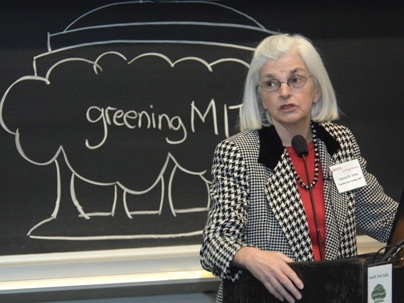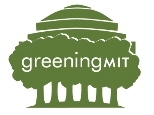When it comes to changing the ways energy is produced and used, MIT has long been at the forefront of research. Now, in addition, students, faculty and staff are working hard to put improvements in energy efficiency into practice on campus.
The efforts are the focus of Energy Futures Week, an annual set of events coordinated by the MIT Energy Initiative to educate, inspire and engage the MIT community in all things energy. Built around the theme of "Greening MIT," this year's events are aimed at raising awareness of, and engaging the community in, campus energy-saving efforts.
Some of those efforts are applications of well-known measures, while others are based on insight and analysis from members of the MIT community. For example, simply testing steam traps in the campus-wide heating system and replacing those that had failed has already resulted in an estimated annual savings of $800,000 -- more than the one-time cost of the replacements. Similarly, a system for continuous monitoring of building systems to identify those that need adjustment or repair has been partly implemented, in the Dreyfus Chemistry building (Building 18) and in the Zesiger Sports and Fitness Center, and could ultimately result in annual savings of $500,000.
Replacements and improvements of lighting systems campus-wide could yield savings of $323,000 annually, and initial implementation in just three areas is already saving $45,000 a year. These are just some of the improvements that have been identified and implemented by a committee called the Campus Energy Task Force, established by the MIT Energy Initiative, whose goal is to help MIT "walk the talk" on energy use.
MIT Executive Vice President and Treasurer Theresa Stone, co-chair of the task force with Professor Leon Glicksman, said the group, working in collaboration with students from the MIT Sloan School of Management and the Department of Facilities, identified a series of measures whose total cost would be about $14 million, which have the potential to pay back their costs in the form of energy savings within three years or fewer.
At an Energy Futures Week kickoff event on Monday, Stone emphasized that a variety of other measures can make a big difference in campus energy use but depend on changes in personal habits. For example, studies of the use of fume hoods on campus, initiated by students a few years ago, found that a single fume hood can use up as much energy as two single-family houses -- and there are more than 1,000 fume hoods on campus.
Simply getting people to remember to lower the fume hood sash when it's not in use can make a significant dent in energy use. As part of the Greening MIT initiative, activities to raise awareness of the savings opportunity will be deployed across campus including offering signs that can be posted next to fume hoods reminding people of this. Similarly, encouraging people to use revolving doors instead of swinging doors (which let out eight times as much heated air), to use two-sided printing whenever possible to reduce waste, turn off lights and computers when they are not in use, and similar personal measures can have a big overall impact if enough people do them.
"We know that these kinds of things work, we know they're doable," Stone said. "The question is how can we build this awareness across the campus."
But it's not enough just to make the changes in buildings and behavior, Stone added. "This is MIT, and we need to be very responsible as far as the measurement techniques." Whenever changes are being made, in order for them to have the maximum impact not only here but on other campuses and in the nation at large, results need to be quantified and "the measurements need to be as clear and defensible as possible," she said.
Jason Jay, a Sloan graduate student and member of the Campus Energy Task Force, pointed out that in some cases, official policies were found to encourage energy waste. For example, custodians had been instructed that when checking offices after hours, lights were to be left as they were found. Now, the Department of Facilities is consulting with key occupants to consider whether, as a policy, custodians should instead turn the lights off unless there was a specific reason not to. "We need to make doing the right thing easier and more obvious," he said.
The Energy Futures Week activities include a workshop on Wednesday from noon to 2 p.m. (with a light lunch included) called "Sustainability in Action: Greening Your Place at MIT," which will help members of the MIT community identify ways to reduce the energy footprint of their own offices, labs, dorms and classrooms.
A complete list of the week's activities is available on the MIT Energy Initiative web site, at web.mit.edu/mitei.
A version of this article appeared in MIT Tech Talk on January 14, 2009 (download PDF).







